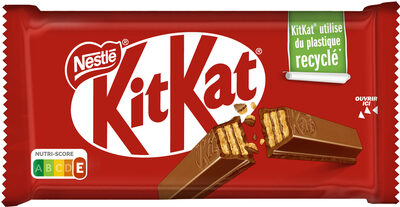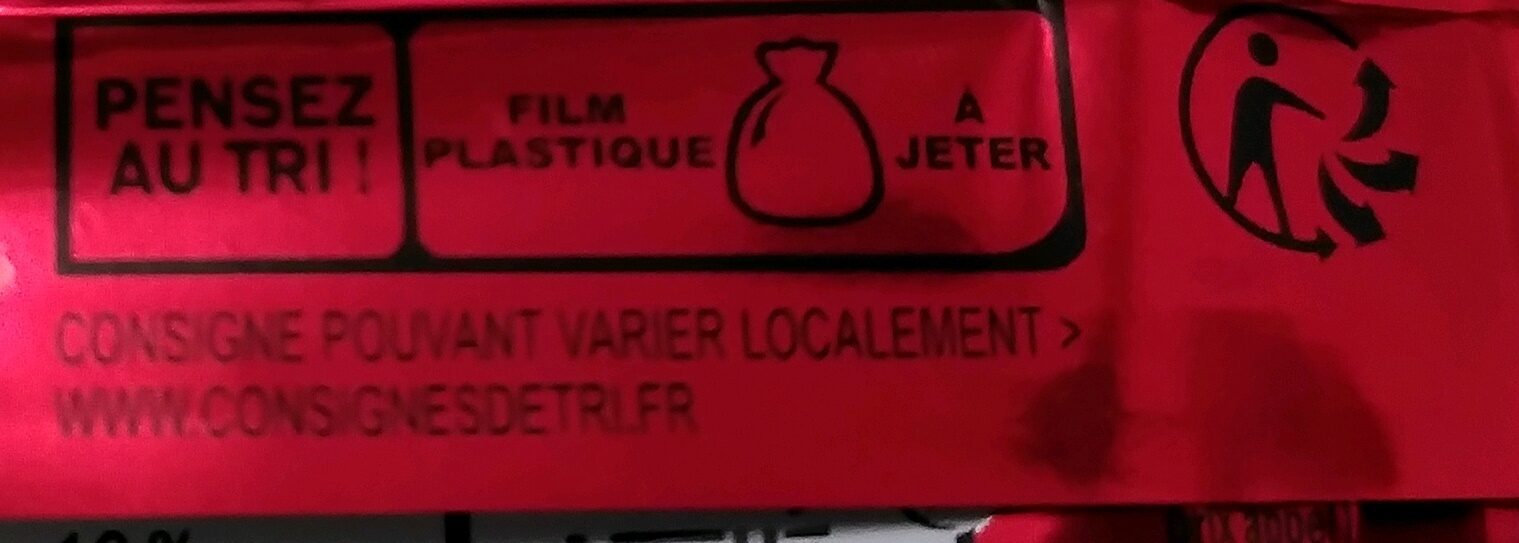KitKat 4 Chocolat au Lait - Nestlé - 41.5 g
Aquesta pàgina del producte no està completa. Podeu ajudar a completar-la editant-la i afegint-hi més dades a partir de les fotos ja disponibles, o fent-ne més amb l'aplicació de androide o iPhone / iPad. Gràcies!
×
Algunes de les dades d’aquest producte les ha proporcionat directament el fabricant NESTLE FRANCE. - Servei al client: Formulari de contacte 0 809 400 412 (service gratuit + prix de l'appel)
Codi de barres: 40052397
Nom comú: Gaufrette croustillante enrobée de chocolat au lait
Quantitat: 41.5 g
Categories: Snacks, Aperitius dolços, Cacau i derivats, Llaminadures, Barretes, Caramels de xocolata, en:bars-covered-with-chocolate, en:Chocolate biscuity bars, fr:Barre chocolatée biscuitée type KitKat
Etiquetes, certificacions, premis:
en:Nestlé Cocoa Plan, Comptador Nutricional, Grau E NutriScore, Aliança Tropical, Triman

Enllaç a la pàgina del producte en el lloc oficial del productor: https://www.kitkat.fr/produits/barre-au-...
Botigues: Vival
Països on es va vendre: França, Mèxic, Illa de la Reunió, Espanya
Matching with your preferences
Altres dades
Preparació: Produit prêt à consommer
Condicions de conservació: A conserver au frais et au sec.
Servei al client: NESTLE FRANCE, 34-40 Rue Guynemer 92130 Issy-les-Moulineaux
Report a problem
Fonts de dades
El fabricant NESTLE FRANCE utilitza Equadis per transmetre automàticament dades i fotos dels seus productes.
Producte afegit per kiliweb
Última modificació de la pàgina del producte per org-nestle-france.
La pàgina del producte, també editada per 5m4u9, asmoth, beniben, chuchordz75, date-limite-app, david1yes, halal-app-chakib, inf, jbgeff, karel, mairoluin, mila2811, moon-rabbit, musarana, openfoodfacts-contributors, packbot, roboto-app, scanbot, soce, teolemon, valeri, yogoff, yuka.RjQ4eElQUU91ZFFsdjhKbjIwak0rb3NzMjQ3NVYwQ3VkY3M5SVE9PQ, yuka.UTdzTUMvOGVnY01PdDg5bDN3cnQ5LzlaOVptbmZucUZET2dYSWc9PQ, yuka.Ulo0UkhmbzZwS1FIdXZSZ3J4aUsrOU1yN1lLQ0REbUxJckFySVE9PQ, yuka.UnJBS1Nma2tqTVFua2ZNYTEwK1AvOXR2MmNDVFVEbWNkOVk5SVE9PQ, yuka.VDZvNU1xc0t2L01Sd3NRSDVRem40LzFSNEkyUVptZUtCUG9OSVE9PQ, yuka.VGFjRVRmb1B0TVFQbWNZN29qV042L2xYM3FDRVJEcVpFc1U2SVE9PQ, yuka.VjZJWU1JbGRndmd3dHNFYXcwdjRvSWhQNTRDdkRWK29EN1U0SVE9PQ, yuka.WG9Jck5ic3NxY0FHbFBNWjF4TDU5LzlUOTdMNGJUeUZPL0E5SUE9PQ, yuka.WHZvU0FMcGFvdnNib3NjUXdnS0wyTlI4eEtlMWJYRzdBTE5PSUE9PQ, yuka.WVBvZkFibzdwZmdCdmZZWS94N2J5c3dwOWNlbUIyZnZPclV6SVE9PQ, yuka.WWFBZVRvZ29sdWNKbDlzNTl3ejhwL2dyL0p1TlFWMlNPOUVYSWc9PQ, yuka.ZFA4dU9ycGIrZHM0dnRnNjdCN0gwWTF3bWNPWmMxK1Jjc2crSVE9PQ, yuka.ZG9JZUFLUUcvdmtxaHZKdit4UFd3ZXhRL3BxSWQweTZkdHRMSUE9PQ, yuka.sY2b0xO6T85zoF3NwEKvlhFubcrPpTDNbz_Qg23Q6-ejB67GWIxI0pmnHqo.













